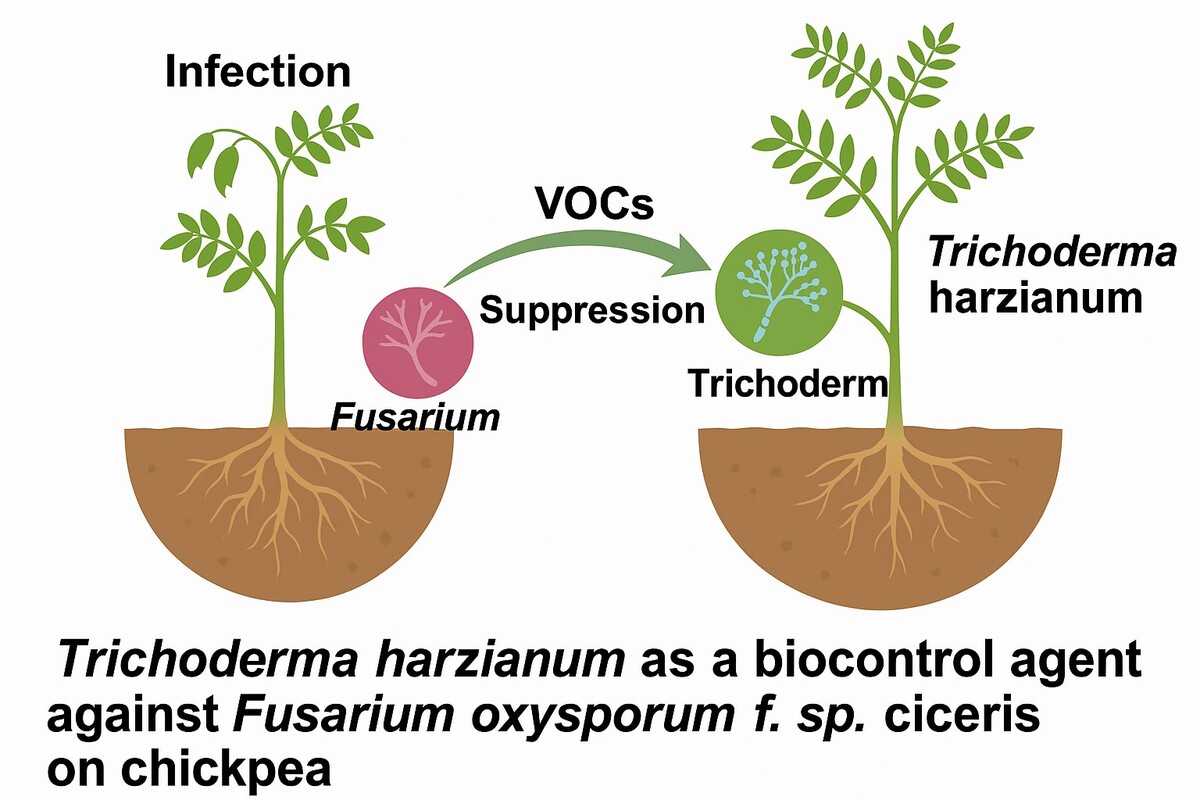ORIGINAL ARTICLE
Dual Culture and VOC Analysis Reveal Trichoderma harzianum as an Effective Biocontrol Agent Against Fusarium oxysporum f.sp. ciceris on Chickpea
1
Plant Protection, Çukurova Unıversity, Balcali-01330, 01100, Adana, Turkey
2
Plant Protection, Çukurova Unıversıty, Balcali-01330, 01100, Adana, Turkey
3
Plant Protection, Çukurova Unıversıty, YENİBARAJ MH. 68066 SK. NO: 10 SEYHAN / ADANA, 01100, Adana, Turkey
4
Biotechnology, Çukurova Unıversity, Hasan MH. 993 SK. NO: 10 SEYHAN / ADANA, 01330, Adana, Turkey
5
Horticulture, Cukurova University, Balcali, 01330, Adana, Turkey
These authors had equal contribution to this work
A - Research concept and design; B - Collection and/or assembly of data; C - Data analysis and interpretation; D - Writing the article; E - Critical revision of the article; F - Final approval of article
Submission date: 2025-02-21
Acceptance date: 2025-07-08
Online publication date: 2025-08-04
Corresponding author
HIGHLIGHTS
- Biological control effectively reduces Fusarium wilt impact sustainably
- Beneficial microorganisms enhance tomato resistance to Fusarium wilt
- Integrating biological and chemical control achieves the best results
- Sustainable disease management relies on integrated strategies
- VOCs act as signaling molecules in plant defense and stress adaptation
KEYWORDS
TOPICS
ABSTRACT
Fusarium wilt, caused by F. oxysporum f. sp. ciceris (Foc), is a major constraint in chickpea production in Turkey, leading to yield losses of up to 50%. This study aimed to characterize the morphological and molecular traits of Foc isolates and evaluate the antagonistic efficacy of three Trichoderma species under in vitro and greenhouse conditions. A total of 20 Foc isolates were obtained from diseased chickpea plants in Tarsus, Mersin, of which 10 were confirmed by PCR amplification of the ITS region. The isolates showed variation in colony morphology, spore type, and pathogenicity, with Foc8, 10, 14, 15 and 20 being the most virulent. Dual culture assays demonstrated that Trichoderma harzianum (T3) had the highest antagonistic activity, inhibiting mycelial growth of Foc isolates by up to 68%. Headspace GC–MS analysis indicated that T. harzianum VOCs were rich in antifungal ketones, in contrast to the alcohol- and acid-dominated VOCs of Foc. Greenhouse experiments revealed that T. harzianum not only suppressed disease development but also significantly enhanced chickpea growth by increasing root biomass, seed weight, and relative water content. These findings highlight T. harzianum as a promising biocontrol agent for the sustainable management of Fusarium wilt in chickpeas. Further field validation and formulation development are recommended to support its use in integrated disease management programs.
CONFLICT OF INTEREST
The authors have declared that no conflict of interests exist.
We process personal data collected when visiting the website. The function of obtaining information about users and their behavior is carried out by voluntarily entered information in forms and saving cookies in end devices. Data, including cookies, are used to provide services, improve the user experience and to analyze the traffic in accordance with the Privacy policy. Data are also collected and processed by Google Analytics tool (more).
You can change cookies settings in your browser. Restricted use of cookies in the browser configuration may affect some functionalities of the website.
You can change cookies settings in your browser. Restricted use of cookies in the browser configuration may affect some functionalities of the website.




